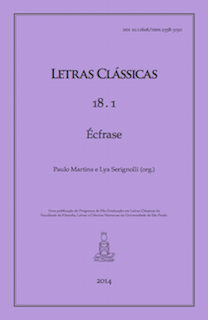O éthos poético de algumas imagines tibulianas
DOI:
https://doi.org/10.11606/issn.2358-3150.v18i1p138-172Palavras-chave:
Tibulo, elegia, imagem, écfrase, éthos, efeitos poéticosResumo
A construção e sugestão de imagens, tenham elas o grau de vivacidade da écfrase ou não, são recursos profusamente utilizados em quase toda a poesia latina, por conseguinte, nem mesmo Tibulo, em sua propalada concisão e simplicidade, poderia ter descurado elaborar “quadros de palavras” e cenas verbais que estabelecessem, colaborassem ou ampliassem a poeticidade de seus poemas, afinal, a prisca ideia enunciada por Simônides de que “poesia é pintura falante e pintura é poesia muda” parece ter sido corrente na Antiguidade Clássica, e o ut pictura poesis horaciano é talvez seu mais memorável e célebre reflexo. Notável é também como a essa percepção de escritores antigos homologam-se de modo aparentemente perfeito muitas codificações modernas da mesma questão: para a semiótica greimasiana, por exemplo, signos figurativos são transportáveis e traduzíveis por qualquer língua natural, porque é apanágio desse – e apenas desse – sistema semiótico codificar todos os demais, e, além disso, eles são categorias abstratas universais, um fato que facilita e habilita a passagem de um sistema a outro. Há que se convir, entretanto, em que a pintura de imagens verbais em poesia é mais um expediente de que lança mão o poeta para criar homologias entre expressão e conteúdo, destinadas a lograr o efeito de permanência da mensagem poética, pela concentração de sentido em investimentos lexicais justos e concisos, ideia que encontra respaldo e consecutividade na de que “nenhum poema jamais é escrito exclusivamente para contar uma história” (“No poem is ever written for its story line’s sake only […]”, Brodsky 1986, 47). Este texto propõe, por isso, fazer a leitura de certas passagens daquelas elegias tibulianas em que predomina a construção de imagens, a fim de investigar seu caráter poético, ou seja, verificar como o plano verbal lhes confere certos efeitos de realidade, como concretude, contraste, etc.Downloads
Os dados de download ainda não estão disponíveis.
Downloads
Publicado
2016-08-22
Edição
Seção
Artigos
Licença
Copyright (c) 2014 João Batista Toledo Prado

Este trabalho está licenciado sob uma licença Creative Commons Attribution-NonCommercial 4.0 International License.
Autores que publicam nesta revista concordam com os seguintes termos:
- Autores mantém os direitos autorais e concedem à revista o direito de primeira publicação, com o trabalho licenciado simultaneamente sob uma Licença Creative Commons Attribution permitindo o compartilhamento do trabalho com reconhecimento da autoria do trabalho e publicação inicial nesta revista.
- Autores têm autorização para assumir contratos adicionais separadamente, para distribuição não-exclusiva da versão do trabalho publicada nesta revista (ex.: publicar em repositório institucional ou como capítulo de livro), com reconhecimento de autoria e publicação inicial nesta revista.
- Autores têm permissão e são estimulados a publicar e distribuir seu trabalho online (ex.: em repositórios institucionais ou na sua página pessoal) a qualquer ponto antes ou durante o processo editorial, já que isso pode gerar alterações produtivas, bem como aumentar o impacto e a citação do trabalho publicado (Veja O Efeito do Acesso Livre).
Como Citar
Prado, J. B. T. (2016). O éthos poético de algumas imagines tibulianas. Letras Clássicas, 18(1), 138-172. https://doi.org/10.11606/issn.2358-3150.v18i1p138-172


